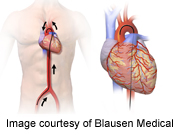
WEDNESDAY, May 23 (HealthDay News) — In a medical science first, researchers turned skin cells from heart failure patients into heart muscle cells that may then be used to fix damaged cardiac tissue.
The researchers said the achievement, done initially with rats, opens up the prospect of using heart failure patients’ own stem cells — a form of cell called human-induced pluripotent stem cells (hiPSCs) — to repair damaged hearts. And since the reprogrammed stem cells would originate with the patient, their immune systems would not reject the cells as foreign, the researchers explained.
They added, however, that many obstacles must be overcome before it would be possible to use hiPSCs in humans this way, and any clinical trial would be at least five to 10 years away.
“We have shown that it’s possible to take skin cells from an elderly patient with advanced heart failure and end up with his own beating cells in a laboratory dish that are healthy and young — the equivalent to the stage of his heart cells when he was just born,” study leader Lior Gepstein said in a European Heart Journal news release. The study’s findings are scheduled for online publication in the journal May 23.
Gepstein is professor of medicine (cardiology) and physiology at the Sohnis Research Laboratory for Cardiac Electrophysiology and Regenerative Medicine at the Technion Israel Institute of Technology and Rambam Medical Center in Haifa, Israel.
One expert in the United States applauded the achievement.
“The ability to source a patient’s own skin cells and transform them into heart muscle is truly revolutionary,” said Dr. Gregory Fontana, chairman of cardiothoracic surgery at Lenox Hill Hospital in New York City.
The results are “another step toward the treatment of heart failure with stem cells,” he said. “Although further work is needed, this work represents another step closer to the clinic.”
In the study, the researchers retrieved skin cells from two male heart failure patients, ages 51 and 61, and then reprogrammed them in the lab to develop into heart muscle tissue, which was then blended with pre-existing heart tissue. Within 24 to 48 hours, the tissues were beating together.
The new tissue was transplanted into healthy rat hearts and started to establish connections with the cells of the rat hearts. Success in animal experiments does not necessarily translate to success in humans, however.
“In this study, we have shown for the first time that it’s possible to establish hiPSCs from heart failure patients — who represent the target patient population for future cell-therapy strategies using these cells — and coax them to differentiate into heart muscle cells that can integrate with host cardiac tissue,” Gepstein said.
Another expert in the United States was cautiously optimistic about the new research.
“After a heart attack, sections of previously normal heart muscle are replaced by scar,” explained Dr. Lawrence Phillips, a cardiologist at NYU Langone Medical Center and assistant professor at the NYU School of Medicine in New York City. “Although we have a number of medications that can help optimize the function of the heart in this damaged state, we have not had treatments to reverse the damage that occurs with a heart attack.”
“This new research is showing a way that the heart can repair itself,” Phillips said. “There is still a lot of work that must be done before these regeneration procedures can be used in patients with heart failure. However, the successes seen in this study — as well as others recently published — show that we are clearly making progress.”
More information
The U.S. National Heart, Lung, and Blood Institute has more about heart failure.

